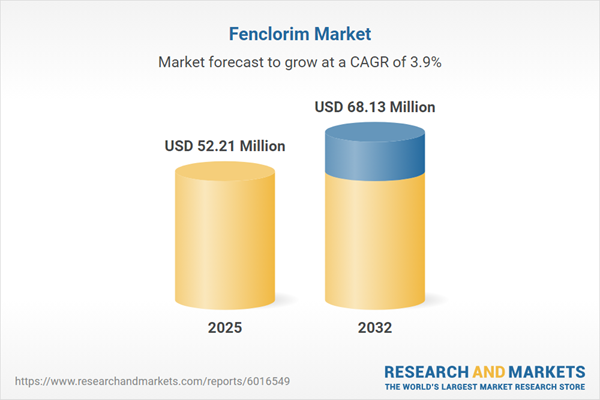Speak directly to the analyst to clarify any post sales queries you may have.
Fenclorim is driving a new era in herbicide safety and crop protection, offering senior decision-makers a practical path to address changing regulatory, operational, and sustainability requirements across the global agricultural sector.
Fenclorim Market Snapshot
The fenclorim market is progressing steadily, marked by an expansion from USD 50.29 million in 2024 to USD 52.21 million in 2025, and projected to reach USD 68.13 million by 2032. This growth reflects a compound annual growth rate of 3.86%, underpinned by the agricultural industry’s increasing prioritization of advanced herbicide safeners. Farmers and commercial growers are recognizing fenclorim’s value in supporting sustainable operations and maintaining effective weed control, aligning with evolving regulatory standards. The shift to integrated crop protection and a focus on sustainable practices fuel ongoing investments and contribute to the development of innovative safener solutions.
Scope & Segmentation: Strategic Coverage of the Fenclorim Market
This report provides actionable insights by segmenting the fenclorim market across key categories essential for business strategy and operational planning:
- Formulation Type: Emulsifiable concentrates offer broad compatibility with leading herbicides; granules are suited for efficient soil targeting; suspension concentrates support precise foliar applications across multiple crop types.
- Crop Type: Adoption is prominent in high-acreage cereals, especially maize, rice, and wheat; uptake continues in potatoes, tomatoes, citrus fruits, and oilseed crops such as canola, soybean, and sunflower.
- Application Method: Methods include foliar spraying, fogging for flexible crop coverage, seed coating, seed dressing for early-stage protection, and both pre- and post-emergence soil treatments for preventive and responsive weed management.
- Distribution Channel: Market access is structured via field agents, traditional and retail-focused agro-input distributors, and the expanding use of digital sales channels, including e-commerce and direct manufacturer platforms.
- End Use: The main end users are commercial-scale farmers and smallholder operations; there is also emerging use in regulated home gardening.
- Regions Covered: Analysis extends across the Americas, Europe, Middle East and Africa, and the fast-growing Asia-Pacific region to enable both micro and macro-level understanding of opportunities and challenges.
- Companies Profiled: Evaluation includes major industry entities such as BASF SE, Syngenta AG, Corteva Agriscience, Bayer CropScience, FMC Corporation, UPL Limited, Adama Agricultural Solutions, Nufarm Limited, Sumitomo Chemical, and Valent U.S.A. LLC.
Key Takeaways: Insights for Decision Makers
- Fenclorim is redefining crop protection protocols by mitigating challenges related to emerging weed resistance and strengthening environmental stewardship in agriculture.
- Precision agronomy and integrated crop management reinforce the demand for safeners that work seamlessly across different crop systems, promoting flexibility and consistency in farm operations.
- Technologies like nano-enabled delivery systems and microencapsulation are enhancing fenclorim’s safety profile, ensuring targeted release and greater stability during complex cultivation cycles.
- Manufacturers are responding to regulatory pressures by improving supply chain transparency and lowering residue levels, a response to greater market emphasis on sustainable crop inputs.
- Strategic partnerships between crop science leaders and agritech innovators are driving advancements in stewardship and scalable deployment, ensuring best practices across diverse geographies.
Tariff Impact on Market Dynamics
Recent United States tariffs introduced in 2025 have reshaped the fenclorim supply chain, prompting market participants to diversify sources, reinforce domestic supplier relationships, and explore alternative raw materials. Senior leaders are prioritizing agile procurement and scenario-based planning to bolster supply resilience and address the complexities of ongoing trade policy shifts.
Methodology & Data Sources
This analysis is based on comprehensive secondary research, expert interviews, and direct engagement with industry professionals. Data has been cross-validated using rigorous protocols to deliver findings that are consistently relevant to B2B decision-making and risk management.
Why This Report Matters
- Establishes a clear benchmark for herbicide safener trends, regulatory drivers, and evolving business strategies, enabling leaders to inform risk-adjusted, compliant decisions.
- Facilitates product innovation and market access planning, supporting organizations seeking to align offerings with growth opportunities and channel shifts across the crop protection supply chain.
- Offers guidance for strengthening operational resilience in the face of supply fluctuations and regulatory changes, supporting proactive strategic responses.
Conclusion
Applying the insights from the fenclorim market analysis supports informed leadership, regulatory alignment, and business resilience for stakeholders navigating the evolving landscape of crop protection.
Additional Product Information:
- Purchase of this report includes 1 year online access with quarterly updates.
- This report can be updated on request. Please contact our Customer Experience team using the Ask a Question widget on our website.
Table of Contents
3. Executive Summary
4. Market Overview
7. Cumulative Impact of Artificial Intelligence 2025
Companies Mentioned
The companies profiled in this Fenclorim market report include:- BASF SE
- Syngenta AG
- Corteva Agriscience, Inc.
- Bayer CropScience AG
- FMC Corporation
- UPL Limited
- Adama Agricultural Solutions Ltd.
- Nufarm Limited
- Sumitomo Chemical Co., Ltd.
- Valent U.S.A. LLC
Table Information
| Report Attribute | Details |
|---|---|
| No. of Pages | 182 |
| Published | November 2025 |
| Forecast Period | 2025 - 2032 |
| Estimated Market Value ( USD | $ 52.21 Million |
| Forecasted Market Value ( USD | $ 68.13 Million |
| Compound Annual Growth Rate | 3.8% |
| Regions Covered | Global |
| No. of Companies Mentioned | 11 |









